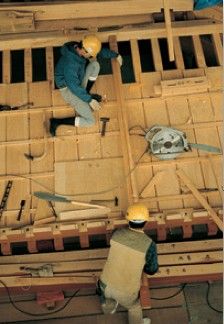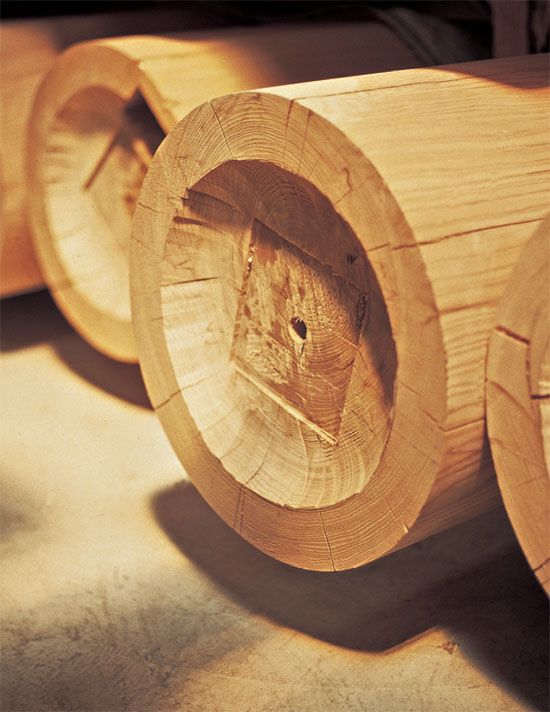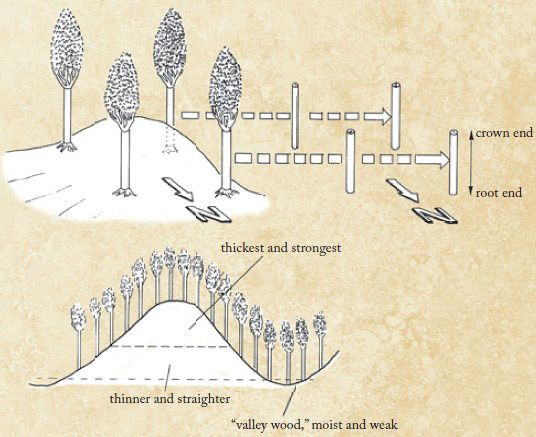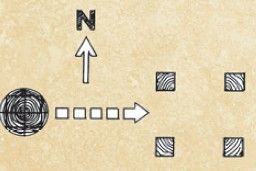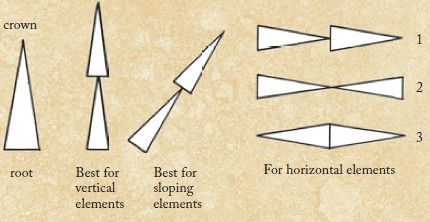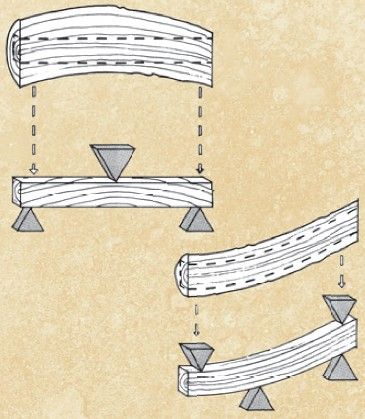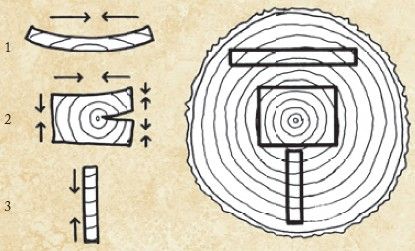CHAPTER 5
SELECTING THE WOOD:
RULES OF THUMB
During the ages when timber was in ample supply, a Japanese carpenter could be assured of adequate prime building material close to home for all but the largest projects. Over the centuries, several rules of thumb evolved concerning the optimum use of wood, which reflected the value placed on continuity between the wood’s natural, living state—what Nishioka referred to as utilizing the “personality” of the wood—and its ultimate disposition within the erected framework. Although the poor state of forest resources in Japan today has made strict observance of these principles impossible, they remain as ideals.
Figure 50 Completed columns for the Picture Hall, each from a single tree.
Figure 51 The tree’s position on the mountain results in different characters of wood. Structural members, particularly columns, should be used in the same orientation they had when alive on the mountain. “Valley wood,” the product of a moist environment, is only suitable for ceilings, etc.
Figure 52 Orientation. If smaller dimension posts are to be used, those at the corners should be taken from the same tree and placed in the same relative positions.
Figure 53 Crown and root joints: 1. Root-to-crown joints are not as good as crown-end joints in horizontal elements such as ridge beams but are preferred in certain cases. 2. Those with crown ends together are preferred. 3. Joints with root ends together should be avoided.
Many of the carpenter’s rules of thumb are based on geomancy, derived in large part from Chinese principles. Geomancy seeks to identify the various natural forces acting on a building site and to compensate for any perceived imbalances. In the tradition under which Nishioka was raised, the principles are called “Shishin” or “Four Gods.” For instance, according to Nishioka, the ideal building site has a mountain to the north, a river to the east, a pond or lake to the south, and a straight road to the west, each represented by a deity (see page 13). When I asked how valid he thought these principles were, he remarked simply: “The Hōryūji site conforms to these rules perfectly, and the temple is almost entirely intact. Yakushiji’s site has no mountain to the north and no pond to the south, and only one building—a pagoda—has survived.” The evidence apparently spoke for itself. Deficiencies in the site, however, can be compensated for. If the needed river is missing, seven willow trees (a tree usually found close to rivers) should be planted in the specified location. In place of a pond, seven paulownia trees may substitute; for a road, seven plum trees; and for a mountain, seven enju trees, a variety of legume.
Carpenters extend the geomantic principles to human relations as well: a certain balance of personalities is required among crew members just as among pieces of timber if a project is to result in the creation of unity. “The carpenters,” said Nishioka, “should all know what will be expected of them, what the goals of the project are. In order to do this, they should try to become one with the master’s heart.”
ORIENTATION
Depending upon its position on a hillside, a tree will be exposed to different conditions of sun, wind, moisture, and so on. Consequently, care is taken to maintain the compass orientation of the timber in the finished building, particularly in the case of columns (Figs. 51, 52). For instance, trees that received strong sunlight due to their location on a southern slope are best used as columns on the southern face of the building. A tree’s structure is naturally designed to resist gravity, being thicker and denser at the base and thinner and lighter at the crown. This vertical relationship should also be maintained, base end always down, crown end always up. In addition, where possible, horizontal members should be joined crown-to-crown (Fig. 53). This is true of inclined members as well.
Figure 54 On the left, the grain acts as a natural arch, resisting the center load. On the right, the grain is an asset when the member bears a cantilever load.
Figure 55 Arrows show the direction of shrinkage. No. 3. is the most stable dimensionally.
A tree’s location while it is growing
affects its usable characteristics in other ways as well. According
to Nishioka, the strongest trees grow above the midpoint of a
mountain, where they receive the best sunlight and the greatest air
circulation (Fig. 51). The trunks
are thicker since the trees there are able to branch quickly and
fully and develop the necessary girth to support a large amount of
leaves or needles without excessive competition from neighbors.
These trees should be used for columns. On the other hand, trees
that stand below the midpoint, where they must compete for sunlight
with trees above and thus send their trunks higher before
branching, are a source of thinner logs that are relatively free of
knots. These logs should be used for exposed members requiring a
fine surface. Trees growing in valleys produce inferior lumber of
high moisture content, but are nonetheless usable for ceiling
boards and other parts requiring neither strength nor fine
finish.
MOVEMENT AND SHRINKAGE
All wood changes shape in response to changes in temperature and moisture. The greatest movement occurs perpendicular to the grain when viewed from the end, that is, radially. Lumber should be milled so as to minimize shrinkage-related distortions, and to insure that the changes that do occur are predictable and can be accounted for in design (Figs. 54, 55). Logs with twisting grain should be used in opposing pairs so that their movements counteract each other.
匠長が工人らへの思いやり 工人たちの心組みは
“Only a compassionate master can mold his carpenters into a unified team.”
Nishioka believed that compassion and deep understanding were the most important virtues for a master carpenter to possess. A master lacking compassion will be unable to shape his workers’ thinking in a way that will enable them to successfully execute the highest quality work.
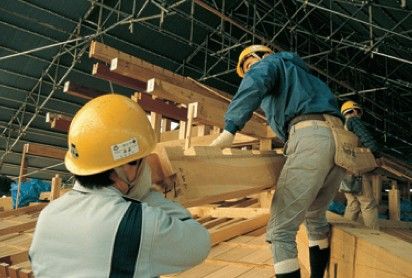
匠長の器量なりこれを正と云う 百工あらば百念あり一つに統ぶるは
“One hundred carpenters means one hundred ways of thinking, and only a master of high caliber can bring them together and tell them what is correct.”
Each carpenter will have his own ideas about the best way to proceed with the work, and the ability of the master to bring them together depends on his leadership skill. Though the process takes time and requires compassion and understanding on the master’s part, once he has communicated his own thinking sufficiently to each worker, he will be able to move them all in the right direction.
